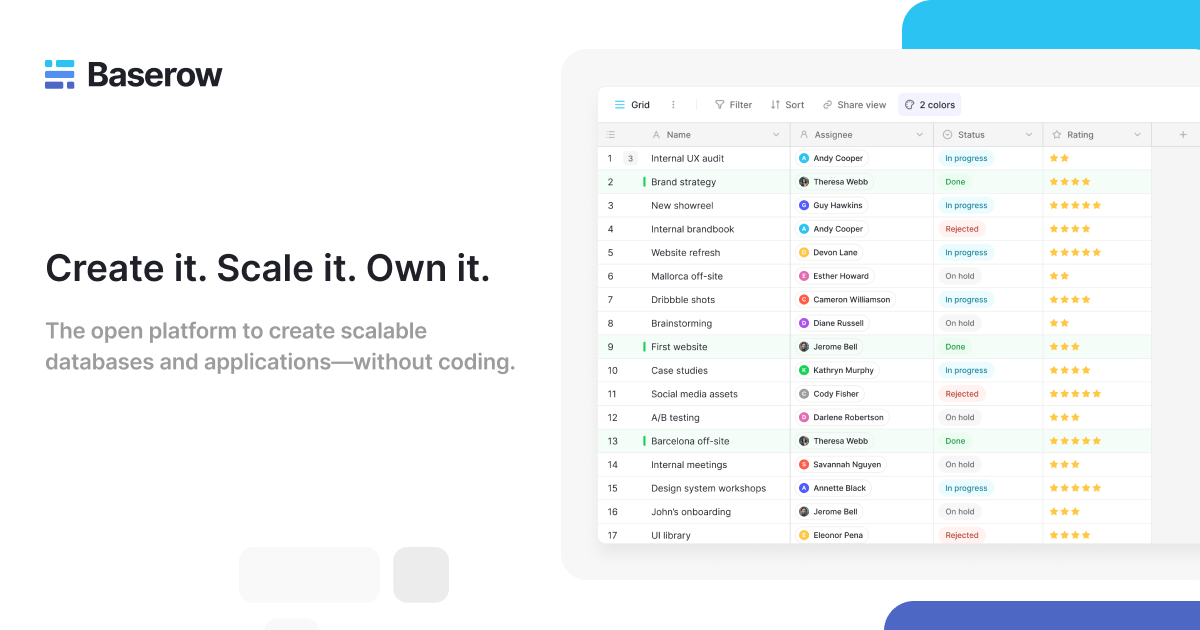No-Code Open Platform Database Creation: Equipping Services to Construct Faster
Wiki Article
Discover How Scalable Databases Can Be Used Without Coding to Boost Your Service Procedures
In today's fast-paced service setting, the capacity to take care of and analyze data effectively is paramount. no-code. Scalable data sources, particularly when combined with no-code options, offer a transformative approach that equips non-technical individuals to enhance procedures.Understanding Scalable Databases
Scalable databases are crucial for modern organization procedures, enabling companies to effectively take care of increasing volumes of data without sacrificing performance. These data sources are made to expand and adapt to the altering needs of a company, guaranteeing that they can deal with larger datasets and even more intricate questions as organizational demands progress.Comprehending scalable databases includes acknowledging their two key kinds: upright scaling and horizontal scaling. Upright scaling, or "scaling up," involves adding even more power (CPU, RAM) to an existing server to improve performance. Alternatively, straight scaling, or "scaling out," involves including much more web servers to distribute the lots, which often leads to better adaptability and mistake resistance.
An additional critical aspect is the style of scalable databases, which can be either relational or non-relational. Relational data sources, such as MySQL and PostgreSQL, are structured and use SQL for inquiries, while non-relational databases, like MongoDB and Cassandra, offer even more versatility with unstructured data.
Inevitably, recognizing scalable databases is essential for businesses aiming to utilize information as a tactical asset, allowing them to remain affordable in a progressively data-driven environment.

Benefits of No-Code Solutions
Opening the potential of no-code services empowers companies to streamline procedures and enhance performance without the requirement for considerable programs knowledge. These platforms allow non-technical users to develop, modify, and take care of data sources easily, therefore equalizing accessibility to innovation throughout groups.One of the main advantages of no-code options is their speed of application. Services can quickly deploy applications and automate processes, considerably minimizing the time spent on growth cycles. This dexterity enables organizations to react immediately to market adjustments and client needs, cultivating an affordable side.
Furthermore, no-code systems reduce dependence on IT divisions for everyday tasks, allowing technical teams to focus on more complicated tasks that need specialized skills. This shift not only enhances source allowance yet likewise advertises innovation within the organization.
Cost-effectiveness is one more benefit, as no-code remedies can decrease advancement and upkeep costs. By reducing the need for coding proficiency, companies can harness the capabilities of their existing labor force without the expenses of working with additional workers.
Popular No-Code Database Equipment
The increase of no-code services has actually led to the introduction of different database tools that provide to businesses seeking performance and ease of access. These tools encourage individuals with restricted technical experience to develop, handle, and control data sources perfectly.
Caspio sticks out for its capacity to construct internet applications with no coding. It permits services to create robust databases and deploy applications quickly, dealing with various industry needs. Flair uses powerful information and easy to use interfaces management abilities, making it possible for organizations to build custom-made applications customized to their process.

Usage Cases in Organization Operations
Just how can services leverage database devices to improve their procedures? Scalable data sources offer companies with powerful capacities to manage and analyze data without the requirement for substantial coding knowledge. These tools can enhance various business procedures, inevitably resulting in boosted performance and performance.One popular usage situation is customer partnership monitoring (CRM) Services can utilize scalable data sources to track customer communications, preferences, and feedback, enabling tailored interaction and much better service. By streamlining this info, teams can team up better and respond to consumer requirements in real-time.
Another substantial application is inventory administration. Firms can utilize no-code data source tools to keep track of supply degrees, track deliveries, and forecast demand. This ensures optimum stock levels, lowers waste, and reduces stockouts.
Additionally, project monitoring can gain from scalable databases by permitting teams to take care of tasks, deadlines, and resources in a combined system. With real-time updates and information visualization, job supervisors can make educated choices.
Beginning With Application
Applying scalable databases in company operations requires a structured technique to make sure effective combination and use. The initial step is to perform a thorough demands assessment, determining specific company requirements, information kinds, and anticipated growth patterns. This foundational understanding will assist the selection of the ideal data source option.Following, select an user-friendly, no-code database platform that straightens with your functional goals. no-code. Lots of modern options offer intuitive user interfaces, enabling non-technical users to take care of information effectively. After picking a platform, develop a clear data design that outlines exactly how information will certainly be arranged, accessed, and kept
Training is essential; ensure that employee are equipped with the necessary abilities to make use of the data source. Take into consideration supplying tutorials or workshops to familiarize staff with the system's performances.
Conclusion
In verdict, the integration of scalable data sources via no-code options presents considerable advantages for service procedures. Eventually, leveraging these modern technologies can lead to improved performance and operational performance, positioning services for sustained development in a competitive landscape.One prominent no-code data source tool try this is Airtable, which incorporates the functionality of a spreadsheet with the power of a database.Exactly how can businesses take advantage of data source tools to improve their procedures? Businesses can make use of scalable databases to track customer communications, choices, and feedback, allowing tailored communication and far better solution.Executing scalable databases in service see this procedures requires a structured approach to make sure effective assimilation and usage.In final thought, the combination of scalable data sources via no-code solutions provides considerable benefits for organization procedures.
Report this wiki page